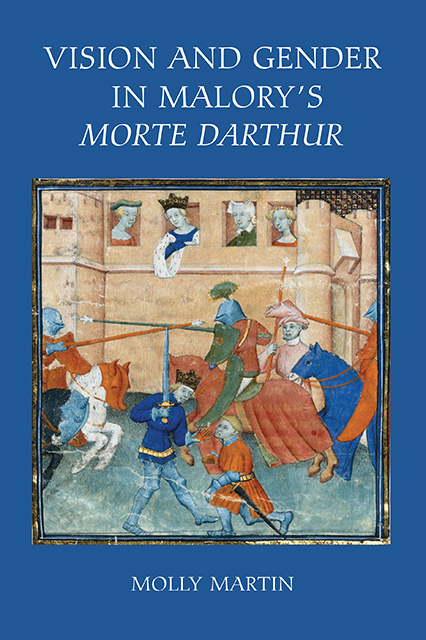Book contents
- Frontmatter
- Contents
- Acknowledgments
- Editorial Note
- Introduction: Masculinity and Vision in the Morte Darthur
- 1 “Beholdyng” Gareth: The Spectacle of Romance Masculinity
- 2 Gazing at the Queen: Trystram and Launcelot
- 3 Seeing Unseen: Palomydes and the Failure of Masculine Display
- 4 Romancing Religion: Competing Modes of Vision on the Grail Quest
- 5 The Female Gaze: Constructing Masculinity with and without Men
- Conclusion: Malory’s Arthurian Visions of Masculinity
- Bibliography
- Index
- Miscellaneous Endmatter
3 - Seeing Unseen: Palomydes and the Failure of Masculine Display
Published online by Cambridge University Press: 01 March 2023
- Frontmatter
- Contents
- Acknowledgments
- Editorial Note
- Introduction: Masculinity and Vision in the Morte Darthur
- 1 “Beholdyng” Gareth: The Spectacle of Romance Masculinity
- 2 Gazing at the Queen: Trystram and Launcelot
- 3 Seeing Unseen: Palomydes and the Failure of Masculine Display
- 4 Romancing Religion: Competing Modes of Vision on the Grail Quest
- 5 The Female Gaze: Constructing Masculinity with and without Men
- Conclusion: Malory’s Arthurian Visions of Masculinity
- Bibliography
- Index
- Miscellaneous Endmatter
Summary
Malory's typical patterns of vision serve to valorize romance masculinity, the ideal performance of which dictates the direction of lines of sight. Malory's romance interrogates and consistently confirms male identity through intromissive vision, introjective sightlines from the image to the viewer. Collapsed gazes, particularly those upon beautiful ladies, problematize the display of masculinity, but generally result in a shift in the locus of the image. As the narrative moves its eyes away from the female and refocuses on the male, it invites a spectacle of masculinity. Concomitant transfers of visual attention are forced on the audiences both within and without the story. Characters and readers alike shift their lines of vision from the female image to that of the male, who is at first trapped in his courtly gaze, but ultimately motivated to display maleness. Both the narrator and the performing knights draw attention to this masculine image. Malory insistently notes this successful realignment of visual lines by registering audience reaction, by drawing sightlines to the masculine performance, and by presenting proper manly images, which almost always consist of prowess in battles or tournaments. The audience becomes an essential component of masculine performance, as identity can only be conferred by an audience. Gareth exemplifies this model, as he constructs his masculinity repetitively before layers of audiences: his opponents, Lyonet, Lyones, and the Arthurian court. Both men and women comprise the audience of the knight whose masculinity is confirmed. The gender identities of Gareth, Trystram, and Launcelot, as have been discussed in the previous two chapters, depend upon their visible participation in – or performance of – acts on behalf of ladies, the king, or the fellowship of knights and its code of ideals. This dependence on the audience, however, suggests that without this confirmation by both male and female communities, masculinity does not exist.
There are indeed several knights whose narrative trajectories notably do not conform to this pattern, either in part or in whole. These knights – through their non-participation, pseudo-participation, or failed participation – perform an aberrant masculinity, one incon sistent with the prescribed norm, one that troubles the male communal identity. Most strikingly, Palomydes proves unable to draw the proper visual attention upon himself.
- Type
- Chapter
- Information
- Vision and Gender in Malory's Morte Darthur , pp. 87 - 117Publisher: Boydell & BrewerPrint publication year: 2010



